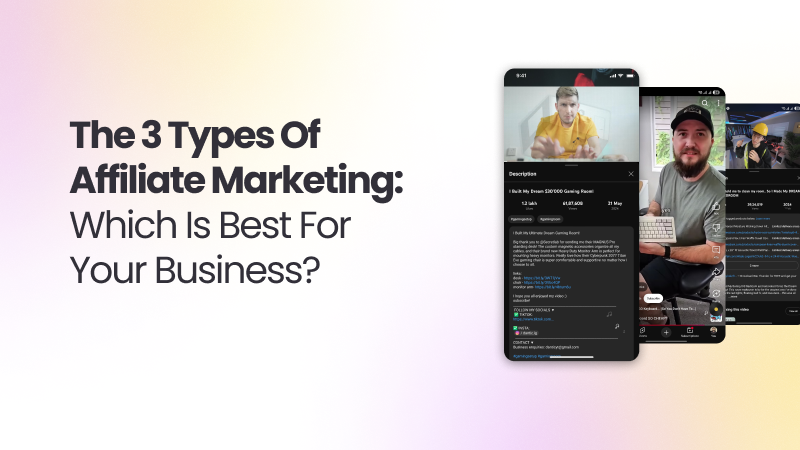
Affiliate marketing is a great way to generate passive income for your business. Aside from more revenue, an affiliate marketing program also brings in more brand awareness and maybe even a new ICP. But before the perks, you have to choose between related, unattached, and involved affiliate marketing.
Have you ever watched your favorite YouTuber, Instagram influencer, or TikTok creator hawk discount codes for their favorite items? That’s affiliate marketing. Brands partner with influencers with an audience that closely aligns with the brand’s ICP. The influencers sell products from the brand and earn a commission from every sale.
Affiliate programs start by the brand conducting influencer research, determining which social platforms most suit their product, and doing some serious outreach. Once a partnership is established, the brand works with the influencer (now, the “affiliate”) to provide brand and messaging resources, get feedback, and manage performance.

Related affiliate marketing involves affiliates offering links to products or services related to their brand without the affiliate actually purchasing or using the products or services themselves.
Say, a video game streamer has links pinned to the top of their chat for a gaming chair or a computer monitor, but they aren’t the exact products that the streamer has used themselves. Because these products relate to the type of content the affiliate produces, it’s related affiliate marketing.
The upside is that this affiliate partnership cuts a lot of the fat of relationship-building. The affiliate doesn’t have to spend time testing, trying, and coming up with messaging describing why they like an exact product. They can simply offer links their audience might like to shop for as a way of being helpful without having to put too much work into it.
The downside is that it could risk destroying audience trust. If there’s a company the affiliate is linking to that doesn’t have a quality product, it could turn the audience away, meaning more work into reestablishing trust down the road. Also, some members of the audience may find a product plug without a full review to be disingenuous.
The most hands-off method of affiliate marketing is the unattached strategy. Here, you get your run-of-the-mill pay-per-click campaign. All a brand does is put an affiliate link in front of an audience via Facebook ads, Google Adwords, or another paid ad service.
Here, the person setting up and running the ads is the affiliate, and they get a commission for every conversion through their link. This method of affiliate marketing is alluring because it doesn’t require an influencer-type audience. Brands don’t need to sift through social platforms to find the right person, and there’s no relationship-building effort being made.
The drawback, however, is that it does nothing to build trust or reputation with the end user. People can see it as a “cash grab” way to advertise instead of a brand taking the time to establish an ethical, close partnership with an influencer they know and trust.
Involved affiliate marketing is the strategy that most closely aligns with the raw definition of “affiliate marketing.” This is where you’ve partnered with the right influencers who truly advocate for your product and service and can authentically recommend it to the right audience. No popups. No banner ads. It’s all about being genuine.
It’s the complete opposite of unattached affiliate marketing and involves some upfront work, resources, and real effort into working closely with influencers. But by doing the work, you get brand trust, a growing customer base, and revenue.
For many businesses, this is the best way to approach affiliate marketing. However, it does come with responsibilities throughout every part of the cycle. Once your affiliates start producing content, the feedback loop, check-ins, performance monitoring, and KPI tracking follow. A close relationship and a more involved partnership usually translate to a more lucrative (and more fun) campaign.
At the end of the day, the right affiliate strategy for you will depend on your business goals. If you’re not concerned about brand reputation or partnerships and just want a few extra dollars a month, go with unattached. If you want to partner with an influencer, but can’t sink the time into a tight-knit partnership, related might be for you.
But if you’re looking to partner with influencers who have built a lot of trust with their audience, your best bet is to reach out for an involved affiliate strategy. It’s a little more work, but we think it’s going to be the most worthwhile.

Regardless of the type of affiliate strategy you go with, you’re going to need a software tool to run the program. With Simple Affiliate, you get an easy-to-use dashboard, all of the key KPIs you need, and automatic payouts. Whether you’re just starting your new program or looking to scale your current one, Simple Affiliate has you covered.
Book a demo with the Simple Affiliate team today to get your affiliate marketing program up and running in no time.